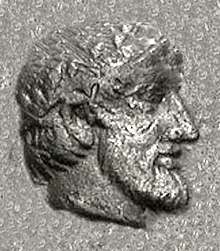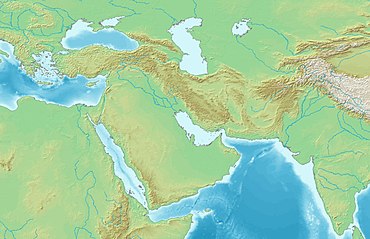Archeptolis
Archeptolis, also Archepolis, was a Governor of Magnesia on the Maeander in Ionia for the Achaemenid Empire circa 459 BCE to possibly around 412 BCE,[1] and a son and successor of the former Athenian general Themistocles.[2][3][4][5]
Archeptolis | |
|---|---|
 Portrait of ruler with olive wreath, Archeptolis coinage. | |
| Allegiance | Achaemenid Empire |
| Years of service | circa 459 BCE to possibly around 412 BCE.[1] |
| Rank | Governor of Magnesia on the Maeander |

Governor of Magnesia
Archeptolis minted silver coinage as he ruled Magnesia, just as his father had done, and it is probable that part of his revenues were handed over to the Achaemenids in exchange for the maintenance of their territorial grant.[3][5]
Archeptolis is said to have married his half-sister Mnesiptolema (daughter of Themistocles from his second wife), homopatric (but not homometric) marriages being permitted in Athens.[6]
Themistocles and his son formed what some authors have called "a Greek dynasty in the Persian Empire".[7]
Archeptolis had several sisters, named Nicomache, Asia, Italia, Sybaris, and probably Hellas, who married the Greek exile in Persia Gongylos and still had a fief in Persian Anatolia in 399/400 BC as his widow.[8] He also had three brothers, Diocles, Polyeucteus and Cleophantus, the latter possibly a ruler of Lampsacus.[8] One of the descendants of Cleophantus still issued a decree in Lampsacus around 200 BC mentioning a feast for his own father, also named Themistocles, who had greatly benefited the city.[9]
Later, Pausanias wrote that the sons of Themistocles "appear to have returned to Athens", and that they dedicated a painting of Themistocles in the Parthenon and erected a bronze statue to Artemis Leucophryene, the goddess of Magnesia, on the Acropolis:[1][10][11]
The children of Themistocles certainly returned and set up in the Parthenon a painting, on which is a portrait of Themistocles.
— Pausanias 1.1.2[12]
They may have returned from Asia Minor in old age, after 412 BC, when the Achaemenids took again firm control of the Greek cities of Asia, and they may have been expelled by the Achaemenid satrap Tissaphernes sometime between 412 and 399 BC.[1] In effect, from 414 BC, Darius II had started to resent increasing Athenian power in the Aegean and had Tissaphernes enter into an alliance with Sparta against Athens, which in 412 BC led to the Persian conquest of the greater part of Ionia.[13]
Coinage
 Coin of Governor of Magnesia Archeptolis, son of Themistocles, circa 459 BC. This coin type is similar to the coins issued by Themistocles himself as Governor of Magnesia. The obverse design could be a portrait of Themistocles.[14]
Coin of Governor of Magnesia Archeptolis, son of Themistocles, circa 459 BC. This coin type is similar to the coins issued by Themistocles himself as Governor of Magnesia. The obverse design could be a portrait of Themistocles.[14] Coin of Archeptolis. Helmeted male and Athenian owl. Circa 459 BC
Coin of Archeptolis. Helmeted male and Athenian owl. Circa 459 BC Coin of Archeptolis. Portrait (Zeus?) and eagle. Circa 459 BC
Coin of Archeptolis. Portrait (Zeus?) and eagle. Circa 459 BC Coin of Archeptolis. Diademed head and eagle. Circa 459 BC
Coin of Archeptolis. Diademed head and eagle. Circa 459 BC Coin of Governor of Magnesia Archeptolis, son of Themistocles, circa 459 BC.[15]
Coin of Governor of Magnesia Archeptolis, son of Themistocles, circa 459 BC.[15] Archepolis coin Circa 459 BC.jpg
Archepolis coin Circa 459 BC.jpg
See also
References
| Wikimedia Commons has media related to Archeptolis. |
- Harvey, David; Wilkins, John (2002). The Rivals of Aristophanes: Studies in Athenian Old Comedy. ISD LLC. p. 200. ISBN 9781910589595.
- Clough, Arthur Hugh (1909). Plutarch's Lives of Themistocles, Pericles, Aristides,Alcibiades, and Coriolanus, Demosthenes, and Cicero, Caesar and Antony: In the Translation Called Dryden's. P.F. Collier & Son. p. 33-34.
- Hyland, John O. (2017). Persian Interventions: The Achaemenid Empire, Athens, and Sparta, 450−386 BCE. JHU Press. p. 22. ISBN 9781421423708.
- KG, Fritz Rudolf Künker GmbH & Co. Künker Auktion 158 - Münzen aus der Welt der Antike. Numismatischer Verlag Künker. p. 49.
- "The history and coinage of Themistokles as lord of Ionian Magnesia ad Maeandrum and of his son and successor, Archepolis, is illustrated by among other things, coins of Magnesia." in Numismatic Literature. American Numismatic Society. 2005. p. 5.
- Cox, Cheryl Anne (2014). Household Interests: Property, Marriage Strategies, and Family Dynamics in Ancient Athens. Princeton University Press. p. 218. ISBN 9781400864690.
- "Eine griechishe Dynastie im Perserreich und ihre Munzpragung" in Nollé, Johannes (1998). Themistokles und Archepolis: Eine griechische Dynastie im Perserreich und ihre Münzprägung, JNG 48/49, 1998/1999, 29-70. (zusammen mit A. Wenninger).
- Harvey, David; Wilkins, John (2002). The Rivals of Aristophanes: Studies in Athenian Old Comedy. ISD LLC. p. 199-201. ISBN 9781910589595.
- Foster, Edith; Lateiner, Donald (2012). Thucydides and Herodotus. OUP Oxford. p. 227. ISBN 9780199593262.
- Paus. 1.1.2, 26.4
- Habicht, Christian (1998). Pausanias Guide to Ancient Greece. University of California Press. p. 5. ISBN 9780520061705.
- Paus. 1.1.2, 26.4
- Smith, William (1867). Dictionary of Greek and Roman biography and mythology. vol. 3. Boston: Little, Brown. pp. 1154–1156.
- Classical Numismatic Group
- Classical Numismatic Group